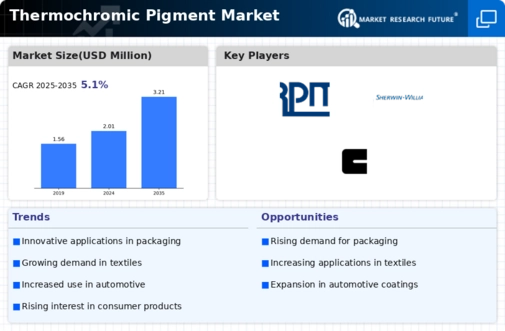Thermochromic Pigment Size
Thermochromic Pigment Market Growth Projections and Opportunities
The thermochromic pigment market is influenced by several key factors that shape its supply and demand dynamics, technological advancements, regulatory landscape, and economic conditions. Thermochromic pigments, which change color in response to temperature fluctuations, find applications in various industries such as printing, packaging, textiles, cosmetics, and novelty items. As consumer demand for interactive and temperature-sensitive products grows, driven by trends in product personalization, safety indicators, and promotional materials, the demand for thermochromic pigments rises accordingly, driving market expansion. Thermochromism is defined as the property of substances to change its color with temperature. Thermochromic pigments are categorized under high-performance pigment which change color owing to its temperature-sensitive nature. Its unique property helps in serving various end-use industries such as paints & coating, printing ink, textile, among others.
On the supply side, factors such as raw material availability, production capacity, and technological innovations play significant roles. Thermochromic pigments are typically composed of specialized microcapsules or liquid crystals embedded in a carrier material. Fluctuations in the availability or cost of these raw materials can impact production costs and pricing strategies within the thermochromic pigment market. Additionally, advancements in pigment synthesis, encapsulation techniques, and application methods contribute to enhancing supply chain efficiency and meeting market demands for high-quality and versatile thermochromic pigments.
Regulatory policies and standards also significantly impact the thermochromic pigment market. Regulatory requirements related to product safety, chemical composition, and labeling drive manufacturers to develop pigments that comply with stringent standards. Compliance with these regulations not only ensures market access but also enhances consumer trust and brand reputation, particularly in industries where product safety and regulatory compliance are critical.
Moreover, macroeconomic factors such as GDP growth, consumer spending patterns, and industrial output influence the overall demand for thermochromic pigments and their downstream products. Economic fluctuations or changes in consumer behavior can affect market growth, while increasing investments in advertising, packaging, and product differentiation can stimulate demand for thermochromic pigments, driving market expansion.
Global market dynamics, including trade policies, geopolitical tensions, and currency fluctuations, also play a crucial role in shaping the thermochromic pigment market landscape. Changes in global trade patterns, trade agreements, or geopolitical events can disrupt supply chains, alter market dynamics, and influence pricing strategies within the thermochromic pigment market.
Furthermore, technological advancements and innovations continue to drive developments within the thermochromic pigment market. Research and development efforts aimed at improving pigment performance, color stability, and compatibility with various substrates contribute to market innovation. For instance, the development of thermochromic pigments with enhanced color transition temperatures or reversible color-changing properties offers new opportunities for market growth and differentiation in diverse applications.







Leave a Comment